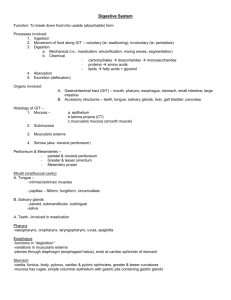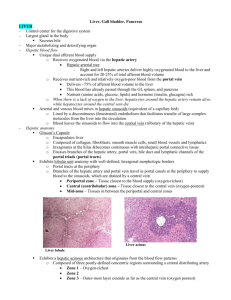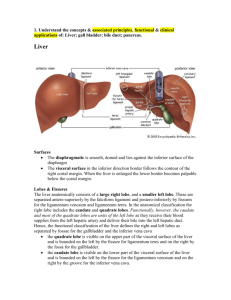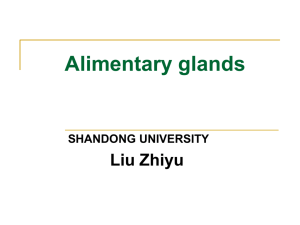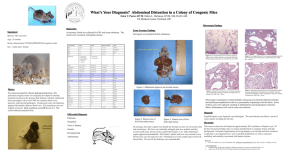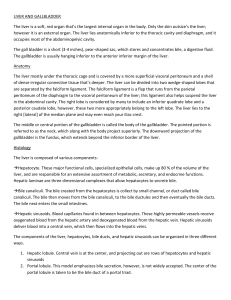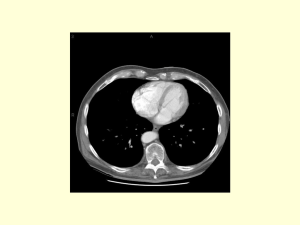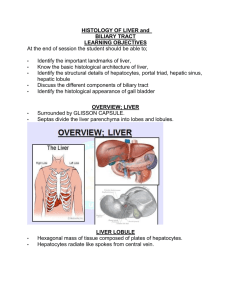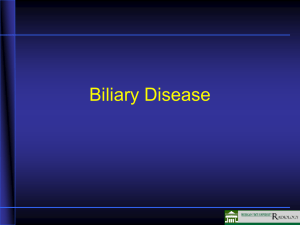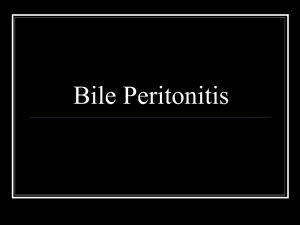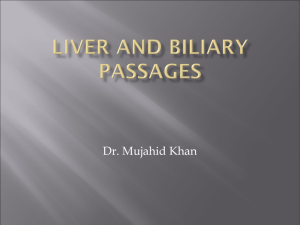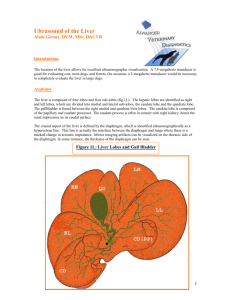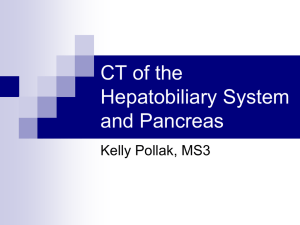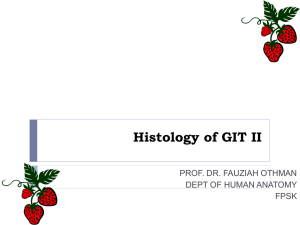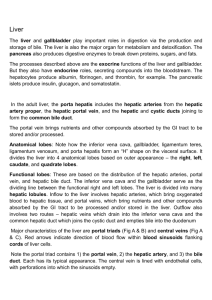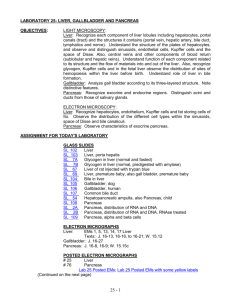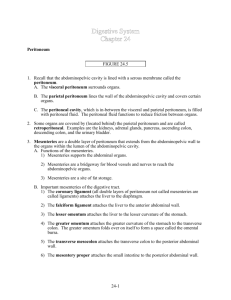The liver
advertisement
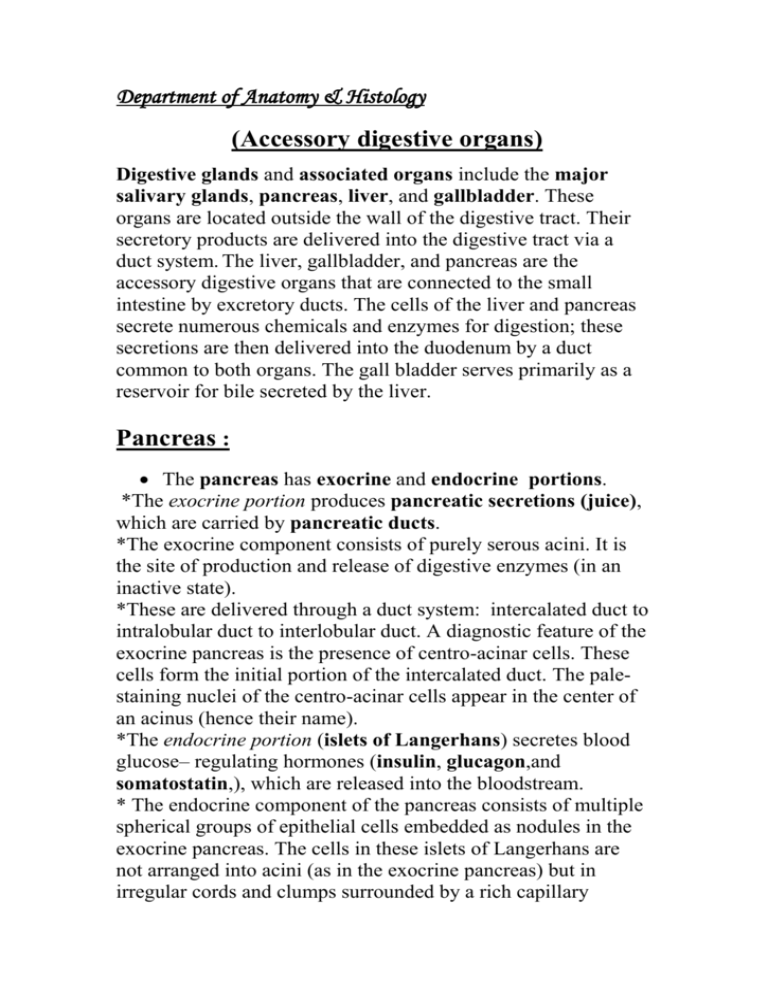
Department of Anatomy & Histology (Accessory digestive organs) Digestive glands and associated organs include the major salivary glands, pancreas, liver, and gallbladder. These organs are located outside the wall of the digestive tract. Their secretory products are delivered into the digestive tract via a duct system. The liver, gallbladder, and pancreas are the accessory digestive organs that are connected to the small intestine by excretory ducts. The cells of the liver and pancreas secrete numerous chemicals and enzymes for digestion; these secretions are then delivered into the duodenum by a duct common to both organs. The gall bladder serves primarily as a reservoir for bile secreted by the liver. Pancreas : The pancreas has exocrine and endocrine portions. *The exocrine portion produces pancreatic secretions (juice), which are carried by pancreatic ducts. *The exocrine component consists of purely serous acini. It is the site of production and release of digestive enzymes (in an inactive state). *These are delivered through a duct system: intercalated duct to intralobular duct to interlobular duct. A diagnostic feature of the exocrine pancreas is the presence of centro-acinar cells. These cells form the initial portion of the intercalated duct. The palestaining nuclei of the centro-acinar cells appear in the center of an acinus (hence their name). *The endocrine portion (islets of Langerhans) secretes blood glucose– regulating hormones (insulin, glucagon,and somatostatin,), which are released into the bloodstream. * The endocrine component of the pancreas consists of multiple spherical groups of epithelial cells embedded as nodules in the exocrine pancreas. The cells in these islets of Langerhans are not arranged into acini (as in the exocrine pancreas) but in irregular cords and clumps surrounded by a rich capillary plexus. Note that the islets are not separated from the acinar tissue by a capsule. The function of the islets is to control carbohydrate metabolism. The alpha cells secrete glucagon, which raises blood sugar, and the beta cells secrete insulin, which lowers it. The somatostatin that is made by the delta cells. Its release locally inhibits both insulin and glucagon secretion . The cytoplasm of alpha cells stains pink, whereas the cytoplasm of beta cells stains blue.The alpha cells are situated more peripherally in the islet, and the beta cells more in the center , also beta cells predominate , constituting about 70% of the islet. Delta cells (illustrated ) are also present in the islets.these cells are least abundant ,have a variable cell shape ,and may occur in anywhere in the pancreatic islet. The liver : The liver is the largest gland in the body, and it has both an endocrine and exocrine function. Its endocrine role is in synthesizing and releasing plasma proteins, such as fibrinogen, prothrombin, lipoproteins, and albumins, into the bloodstream. Its exocrine role is the production of bile. Bile is important in emulsifying and degrading fat into smaller molecules and in carrying wastes out of the body. Bile, produced by the hepatic cells, is collected first in small bile canaliculi and then in small hepatic ductules. It is carried away from the hepatic lobules in larger branches of the bile duct. The removal of bile from the liver via a duct system represents the exocrine function of the liver. The liver is organized into lobes, which are subdivided into lobules. Each liver lobe is surrounded by a thick connective tissue capsule, and each lobe is subdivided into lobules (repeating hexagonal units) by looser connective tissue (Glisson's capsule). In the human, however, this connective tissue does not completely outline the lobule. The structural plan of the liver is a reflection of its vascular supply. Blood enters the liver via the hepatic artery and portal vein, which send branches to the hepatic lobules. Within the lobules, blood travels between the plates of hepatic cells, in sinusoids, toward a central vein. It leaves the lobules via branches of the hepatic vein. The axis of the classic or anatomical lobule is the central vein, which is the beginning of the hepatic vein. In this case, each lobule consists of plates of hepatic parenchymal cells that radiate out from the central vein. Separating the radial plates of the cells are the hepatic sinusoids, which are lined by endothelial cells. Kupffer cells (macrophages), span the sinusoid and attach themselves to the endothelial lining. These cells are macrophages. The other cell type found in the perisinusoidal space is the hepatic stellate cell also called the Ito cells. These cells are primary storage site for fat and much of the body's vitamin A. A portal canal also called portal area occurs in the connective tissue at the marginal angles of the lobules. Its three components, known collectively as the hepatic triad, are branches of (1) the hepatic artery, (2) the portal vein, and (3) the bile duct. Lymph is collected in lymphatic vessels, which accompany the hepatic triad in the portal canal. Gallbladder : The gall bladder is a small hollow organ attached to the inferior surface of the liver . bile is produce by liver hepatocytes that leaves the liver and flows to, is stored , and concentrated in the gallblader .The gallbladder is not gland, because its main function is to store and concentrate bile by absorbing its water. The wall of the gallbladder consists of a mucosa , a fibromuscular layer , a perimuscular connective tissue layer , and a serosa on all of its surface except the hepatic, where an adventitia attaches it to the liver. The mucosa exhibits temporary folds , which disappear when the gallbladder is distended with bile. These folds resemble the villi in the small intestine; however, they vary in size, shape and irregular arrangement. The crypts or diverticula between the folds often form deep indentations in the mucosa. In cross section, these diverticula in the lamina propria resemble tubular glands; however, there are no glands in the gallbladder proper (except in the neck region). The lining epithelium is a simple tall columnar epithelium with lightly stained cytoplasms and basal nuclei. The lamina propria contains loose connective tissue and some diffuse lymphatic tissue. The smooth muscle fibers in the fibromuscular layer are interspersed within the layers of loose connective tissue that are rich in elastic fibers . In contrast to other organs in which a serosa or adventitia covers the muscular layer, the gallbladder has a wide layer of peri muscular loose connective tissue ,which contain blood vessels, lymphatics, and nerves; serosa is the outermost layer and covers all of these structures. The wall of the gallbladder does not contain a muscularis mucosae or submucosa .
